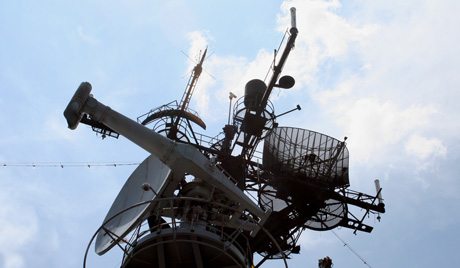Russia on Tuesday activated a radar warning system against incoming missiles in its exclave of Kaliningrad on the borders of the EU, in response to Western plans for a US missile shield in Europe.
President Dmitry Medvedev announced that the Voronezh-DM station was moving on to immediate combat readiness, days after threatening to deploy missiles in Kaliningrad amid a growing dispute with the West.
“I expect that this step will be seen by our partners as the first signal of the readiness of our country to make an adequate response to the threats which the (Western) missile shield poses for our strategic nuclear forces,” Medvedev said.
Using rhetoric reminiscent of the Cold War, he added: “If this signal is not heard, we will deploy other methods of protection including the taking of tough countermeasures and the deployment of strike forces.”
Medvedev said last week Russia was prepared to deploy Iskander missiles, which officials say have a range of up to 500 kilometres (310 miles), in the Kaliningrad exclave that borders EU members Poland and Lithuania.
Romania and Poland have agreed to host part of a revamped US missile shield which Washington said is aimed solely at “rogue” states like Iran but Moscow believes would also target its own capability.
NATO member Turkey has decided to host an early warning radar at a military facility near Malatya in the southeast as part of the missile defence system.
Medvedev, who visited Kaliningrad to sign the decree on activating the station, said Russia needed to hear more than promises from the West to resolve the standoff.
“Verbal statements do not guarantee our interests. If other steps are made then of course we are ready to listen,” Medvedev added in a statement from Kaliningrad broadcast on state television.
“We can no longer be content with verbal promises that the (US missile shield) system is not aimed against Russia. These are empty statements and do not guarantee our security.”
But he said that the activation of the Kaliningrad station “does not close the door for dialogue” with the United States on missile defence.
Kaliningrad is part of the former German East Prussia region that was annexed by the Soviet Union at the end of World War II and remains one of Moscow’s prime territorial strategic assets.
The RIA Novosti news agency quoted Defence Minister Anatoly Serdyukov as saying that the station could keep track of 500 objects at a range of up to 6,000 kilometres.
The local military commander Lieutenant Colonel Sergei Brotskov said in comments released by the Kremlin that work on the station had only started in June 2010 but had been accelerated due to tensions over missile defence.
He said that the station would be able to determine “the origin, type and destination” of a missile fired against Russia even from the Atlantic Ocean or Mediterranean.
The move comes in the run-up to legislative elections on December 4, where Medvedev is leading the list of the ruling United Russia party amid an atmosphere of growing nationalism in Russia.
Medvedev has championed a reset of relations with the United States under President Barack Obama. But Prime Minister Vladimir Putin, who traditionally has a more prickly relationship with the West, is set to become president in 2012.
An analyst said the decision to activate the system was important but had to be seen in a domestic context.
“Data from this station will allow Russia’s leadership to make a decision about a retaliatory nuclear strike, should such a hypothetical need arise,” said Mikhail Khodaryonok, editor of journal Aerospace Defence.
But he described the announcement as mainly “pre-election rhetoric” given that both the US missile shield and the Russian system are defensive in nature.
“You would really need to have a vivid imagination to link it to the US missile defence system.”










